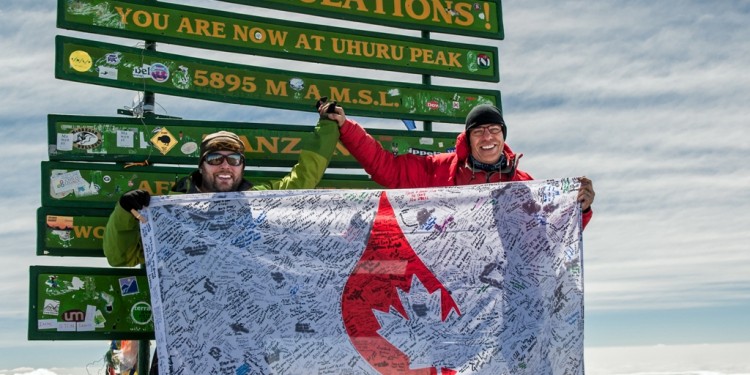How to add meaning without a career change: a conversation with Jaime Stein
Jaime Stein (pictured left) represents a different kind of Purple Sheep- one who uses his skills for good without breaking away from the corporate herd. For those of us who want to make a difference but can’t find the right impact job just yet, or are not ready to leave our current gigs, we can learn so much from people like Jaime. That’s why we’re so excited to start sharing more stories from change makers, social intrapraneurs and super volunteers. Not only do their actions provide fulfillment to their lives it also had the added bonus of helping their careers. In the first of our series we profile Jaime Stein and his role in helping build Canada’s national cord blood bank.
But first… a little about Jaime professionally.
Jaime is a Customer Success Executive at Hootsuite where he builds relationships with some of the world’s most prestigious organizations to help support their social media activities. Jaime has an extensive background that includes expertise in social media and content marketing in finance, professional sports and hyper-growth technology businesses. He is an experienced advisor to senior leaders, including the C-Suite, on social media engagement strategies and crisis communications.
What inspired you to participate in the campaign ‘For All Canadians’ to help build Canada’s new national cord blood bank?
I lost my dad to leukemia in 2006. He had been sick with a different blood disease, which he had battled for a while, but was still able to live a normal life. The leukemia came on fast and he died within a month of his diagnosis. It was difficult to lose my strongest champion – the person I always turned to when faced with difficult decisions. For the first time in my life, I really felt helpless. There was nothing I could do for him.
I didn’t want anyone else to have to feel that way, so I started working with Canadian Blood Services (CBS) to help raise awareness for the Unrelated Bone Marrow Donor Registry. Fast forward five years and I was approached by CBS to help raise funds to create Canada’s national public umbilical cord blood bank. The opportunity to participate in the campaign ‘For All Canadians’ was a chance to help make a massive difference for Canadians who may, at some point in their life, require a cure for a disease like leukemia.
Describe the process you went through, identifying the strategy you took to lead change and any challenges you faced.
The biggest challenge for me was my age. I was the youngest member of the fundraising cabinet and I didn’t have many connections to people who could make six or seven figure donations. But, I did have the skills to communicate and tell our story through social media. I also had access to decision makers at my company, Tangerine, who understood the importance of community and making a difference for Canadians. It was through these two avenues that I was able to make my biggest impact.
My strategy was to focus on what I was good at: Communications. I was able to raise nearly $30,000 in personal donations through a social media driven campaign that was focused around our team of 25 individuals climbing Mt. Kilimanjaro. I created a blog and shared my personal story including updates about training for the climb and various important facts and benefits of creating a public cord blood bank. This helped build a groundswell of support and awareness for our initiative. Our climb team raised over $350,000 of the $12.5 million campaign goal, which exceeded expectations.
Moreover, thanks to the support of people like Tangerine CEO Peter Aceto, the bank contributed $100,000 towards the campaign. I was overjoyed by the support that Tangerine put behind the campaign. It was a great example of how a corporation can direct its community support towards employee-driven campaigns. I think it helped inspire more employees to step forward and share their personal causes and resulted in the bank making a greater impact.
Did working on a meaningful side project help with your career?
Absolutely! I was exposed to some of Canada’s top business leaders on our fundraising cabinet. People like Dr. Graham Sher, the CEO of Canadian Blood Services, and others. It was a privilege to sit in meetings and learn by example, observing how these great leaders handled different situations.
This experience also helped me step out of my comfort zone. Asking people for money wasn’t something I had done in the past as a journalist. Asking people for large donations helped me refine how I approach situations in my life where I need to get to a certain outcome – be it on a project at work or negotiating bedtime with my kids. I learned how to make my point in a succinct manner, how to build support for a cause through a mix of storytelling and facts, and of course, how to get to yes.
What advice would you give other intrapraneurs or change makers who want to make a difference (but without leaving their company or job)?
Opportunities are everywhere. If you want to make a difference, let people know. You never know who is looking for people for their next campaign or initiative. On the flip side, if you want to help an organization, just ask. In my case, I picked up the phone and called CBS the day after my father was diagnosed with leukemia. I was working in radio at the time and I offered to help get the world out about bone marrow donations. They called me back right away. Within two weeks, we had recorded the first-ever bone marrow donation PSA in Canada and our relationship has gone on for nearly a decade.
To that point, if you want something, go after it. It sounds cliché, but lots of people sit around talking about what they want to change, but they never act. Be bold. Be passionate. Act!
Is there anything else you want to say that we didn’t ask you about?
I think it is important to pick a cause that you are passionate about and try to focus your energy in one place. When I was younger, I tried to volunteer for too many causes. As a result, I wasn’t able to give 100% of myself to any of the initiatives I was helping on. Ultimately, I had to drop some stuff. It was hard for me to abandon something that was unfinished and it was hard for the organizations I was working with. There is nothing wrong with saying “no” or “not now” to certain initiatives. It isn’t easy, especially if you want to help, but it is important to maintain balance in your life and to ensure that when you do commit to something, you go all in.
Like what Jaime has to say? Follow him on twitter.





No Comment